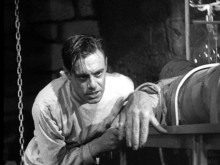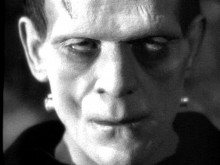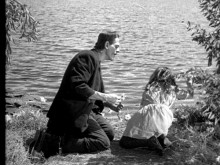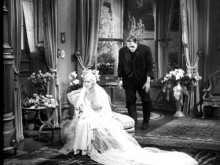What is more logical for the Thursday Horror Picture Show to follow Gothic with than Frankenstein (1931) itself? James Whale’s film was only the second entry in the first wave of cinematic horror, but it’s also what can be called the first modern horror picture. By that I mean that the film is unapologetic about its horror content. There is none of the reticence of Tod Browning’s Dracula (1931) here. Frankenstein is a film that sets out to deliver genuine shocks—and shock effects—in its tale of mad scientist Henry Frankenstein (Colin Clive) bringing to life a monster (Boris Karloff) pieced together out of body parts purloined “from the grave, from the gallows” and indeed anywhere.

Ironically, James Whale took the project because his first two films—Journey’s End (1930) and Waterloo Bridge (1931)—had WWI backgrounds. Whale had been brought to Hollywood on the strength of his stage productions of Journey’s End (in the West End and on Broadway) and he feared that all this was going to get him typecast as nothing but a war specialist. Well, tackling Frankenstein solved that—and now he’s forever known for it and the three horror films he made in its wake. Sometimes you just can’t win, but most of us aren’t complaining because Whale’s quartet of horror pictures are among the wonders of film.

Whale’s first film showed little of his cinematic bravura. Waterloo Bridge, on the other hand, offered us something like the Whale we now know, but Frankenstein cemented the deal. Here Whale emerges in full flower—the stage director in love with the theatrical and drunk on the possibilities of film. Those two things—theater and cinematic possibilities—color everything about the film. Everything is theatrical—including the film’s gothic landscape “exteriors” with their painted backdrops. The creation of the monster is a theatrical event—complete with an audience for the specific purpose of being an audience. Henry Frankenstein even remarks, “Quite a good scene, isn’t it? One man crazy—three very sane spectators!” And he’s right—it is a good scene.

At the same time, Whale is on the loose cinematically, ignoring rules as he goes. He even opens one scene with three of his trademark gigantic closeups before he offers us the traditional establishing shot. The effect is still startling. The creation scene may be theater, but the technique—there are more than 70 cuts in the sequence—is pure film. His film is filled with shaved sets so that his camera can literally pass through walls—walls which, it should be noted, are almost always decorated with things that would hardly be in the middle of a solid wall. It doesn’t matter to Whale—what he wants is the effect. And he gets it. He aims for spectacle and achieves it.

He’s also a master showman—look how long he keeps us from getting a look at the monster. The creature’s face is bandaged when he’s on the operating table. He’s kept offscreen afterwards for a cutaway to Henry’s perturbed father (Frederick Kerr). Then when the film does return to Frankenstein’s watchtower laboratory, there’s a fairly long dialogue between Henry and Dr. Waldman (Edward Van Sloan) about the creature (“You have created a monster and it will destroy you”). When the monster finally does show up, the lights are lowered and then he backs into the room, slowly turning to face us—whereupon Whale pays off with three ever-closer shock closeups. Today, we know what the monster looks like. Imagine the effect in 1931.

There is so much to this film that it would be possible to go into it scene by scene—in some cases, shot by shot—but there’s not space for that here. However, if you like your subtext—and Whale is full of (possibly inadvertent) subtext—consider the monster in terms of Whale’s homosexuality. Consider the monster—the reason Henry has put off his wedding and gone to live in this phallic tower—as the embodiment of that sexuality, and as something that is quickly shoved into a dungeon (closet) the minute it’s inconvenient. Consider the price Henry pays for trying to ignore the monster and his responsibility. You can take these concepts through the entire film and on into Whale’s other work. (Trust me, I’ve done it in publications that allowed for the requisite length.) But if that bothers you—and it does bother some people—you can just sit back and watch the original James Whale horror show about “The man who made a monster,” and also made a star out of Boris Karloff.




Aaah… to see this projected! I am getting to catch a screening of DRACULA at the Sydney Film Festival, but I’d much prefer to see this (or even more, BRIDE OF FRANKENSTEIN).
Aaah… to see this projected! I am getting to catch a screening of DRACULA at the Sydney Film Festival, but I’d much prefer to see this (or even more, BRIDE OF FRANKENSTEIN).
All Whale films from Waterloo Bridge (1931) through Show Boat (1936) greatly benenfit from being seen large. But don’t sneeze at seeing Mr. Browning’s Dracula on the big screen. The staginess of its drawing room scenes is very different when the characters are more than a few inches tall. Please tell me, they aren’t showing it with that Philip Glass score. (Nothing against Glass, but that score isn’t very good and it doesn’t belong on that film.)
Don’t forget that Mr. Souther has taken it into his head to announce the next line-up of horror pictures at tonight’s showing.
And for anyone who’s curious, yes, we will be selling AFS subscriptions tonight, too. (Actually, they’re available at the theater anytime.)
Frankenstein still has it — 79 years old and it still gave us our biggest turnout yet.
For those of us that couldn’t make it, can you share the expanded horror schedule?
How can one not love the film that started one of the two greatest franchises in film history? Frankenstein on the big screen! I’m insanely jealous.
For those of us that couldn’t make it, can you share the expanded horror schedule?
Let’s see if I can get this right. We still have Lair of the White Worm, The Gorgon and The Sentinel in this set. Next up is Phantom of the Paradise, which was a requested title (though one we’d planned on anyway). Then there’s Paul Morrissey’s Blood for Dracula (aka: Andy Warhol’s Dracula), our X-rated response to the new Twinklight movie that opens that week. And then Bad Taste, The Invisible Man (on and for James Whale’s 121st birthday), and July closes out with Cronenberg’s The Fly.
How can one not love the film that started one of the two greatest franchises in film history?
Okay, I have to ask what the other one is…
Frankenstein on the big screen! I’m insanely jealous
We’d have loved to have you, but if memory serves you’re not local. You’d still be welcome at any time.
The expanded schedule covers the 5 Thursdays in July. What will be showing immediately following THE SENTINEL on June 24th, THE ABOMINABLE DR PHIBES?
I knew I was the wrong person to ask (Justin is off gadding about somewhere for the weekend). I’m not sure where all these fall, but I left out Phibes by accident. The one on the 24th is Phantom of the Paradise. I know, however that The Invisible Man is July 22.
Okay, I have to ask what the other one is…
That would be Dracula. Dracula movies, not post-modern Vampire crap.
Dracula movies, not post-modern Vampire crap.
I do understand the distinction.